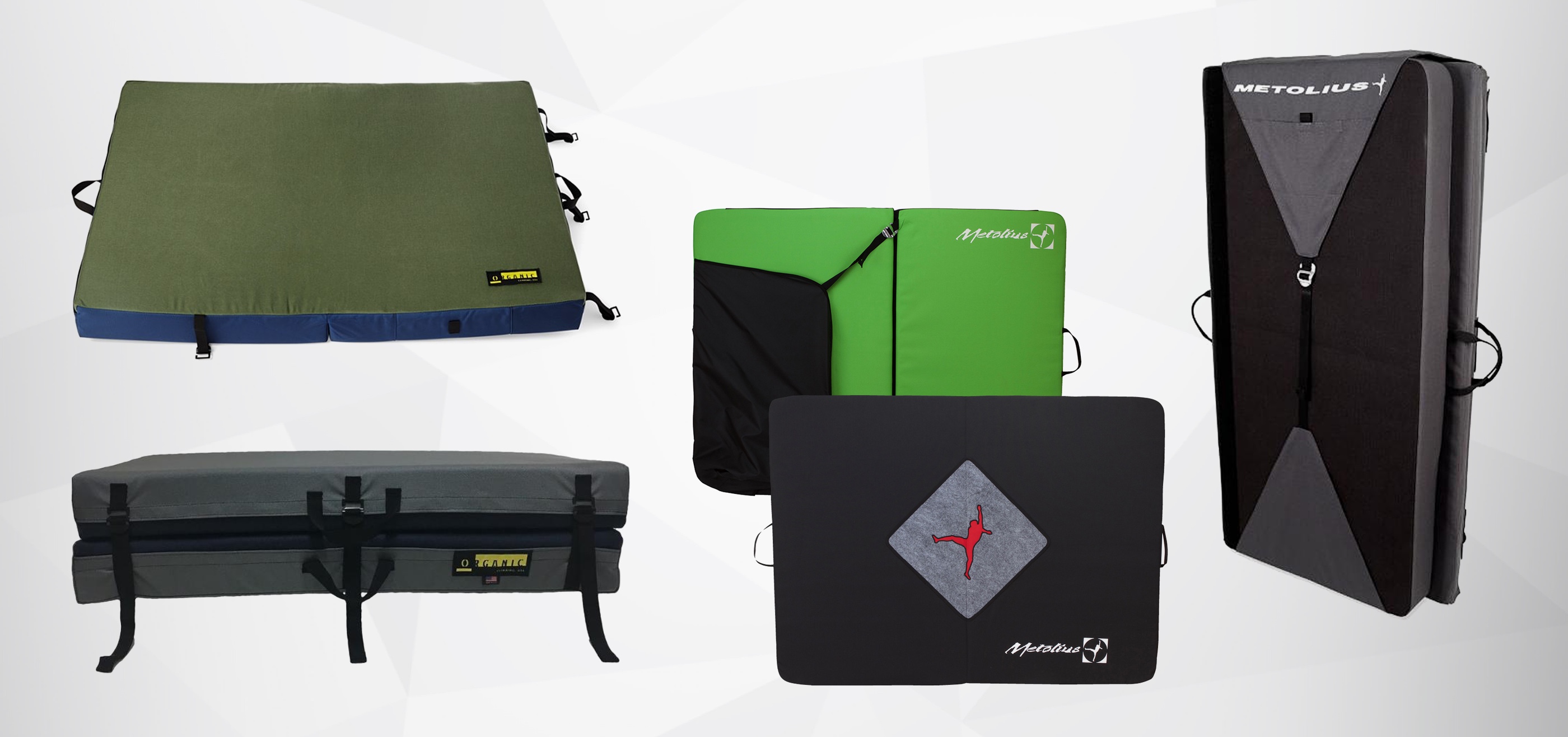Contrary to all the silly questions you may get on the approach and at the parking lot, bouldering crash pads aren’t mattresses. Nor are they yoga mats, bear protection shields, or moose saddles.
Take me to the crash pad recommendations!
A bouldering crash pad is used for bouldering (duh). Okay and sometimes as a mattress in the vans of the cheapest dirtbags, though there’s no faster way to blow out pads than by sleeping on it, so please don’t do that on any crash pad you plan on actually using for climbing.
The Purpose of a Crash Pad
It might best be described by its intended use: crash pad. Why? Well, the primary purpose of a crash pad is to serve as a safe landing when you fall off a climb and crash to the ground. It’s common knowledge we boulderers spend more time falling than actually climbing.
Therefore the best bouldering pad is whatever one is going to be utilized in such a way that it’ll keep you from getting hurt. Let’s unpack that a bit.
How Bouldering Crash Pads are Made
Some may wonder, “What’s so special about bouldering crash pads? Why pay so much money when it seems any old chunk of foam or old mattress will do?” The short answer is “no, not any old mattress will do.” Bouldering pads are specifically designed to maximize portability and minimize fall impact. But how? Specifically, how do crash pads work to protect climbers above and beyond a basic mattress?
To answer that, we need to understand a little bit about the components that go into a crash pad and why they matter.
There are two main components to a crash pad: the shell (exterior) and the foam (interior).
The foam interior is obviously the most important, so let’s start there. There are two main types of polyurethane foam when it comes to crash pads:
- Open-cell foam: As the name suggests, open-cell foam features open cells that allow air to pass in, out, and between the cells. This foam is made with an inflating agent (usually sodium bicarbonate) that gives the foam a springy quality. That’s why it reinflates after being compressed. This makes it soft and breathable (meaning a more comfortable landing surface), as well as flexible (meaning it conforms to the landing surface better). Most of what we think of as foam is open-cell foam, which is why we can’t use any old piece of foam in place of a crash pad. No crash pad features only open-cell foam because it can bottom out if you’re falling far enough.
- Closed-cell foam: Closed-cell foam, on the other hand, features closed cells not connected with each other, so no air can pass in or out of the cell. That makes it denser and thus more durable, though the rigidity also makes it unable to conform to uneven terrain. It’s considered a “hard foam” whereas open-cell foam is a “soft foam”. This hardness doesn’t make it very comfortable to fall directly onto, but it does the heavy lifting when it comes to distributing the force of impact. The closed-cell foam also serves as a natural moisture barrier, which means a crash pad with a closed-cell core is less likely to get wet and moldy.
Most pads feature a combination of open and closed-cell foam, though the possibilities of how they can be layered are just about endless. Some feature a simple two-layer design of soft, open-cell foam on top for a cushy landing and hard, closed-cell foam on the bottom for support. Others utilize three layers, sandwiching the closed-cell foam between two layers of open-cell foam for flexibility to both make the pad conform to the ground better as well as provide a more comfortable landing zone.
Just because the foam is what gives a crash pad it’s crash protection doesn’t mean we should discount the integrity of the shell. The shell is what protects the foam and is thus what ultimately determines a large part of your pad’s lifespan. Think about it: you’ll be subjecting your crash pad to some tough environments, your falling body aside, so you want to make sure you can protect it from the ground and the elements.
Most crash pads feature a nylon shell, though the durability (aka the denier) of that nylon varies. Generally, look for 600D+ nylon, as that will provide a significant amount of abrasion and weather resistance, even without a weather-resistant coating (though that’s an added bonus, too). Ballistic nylon or rubberized nylon are top of the line in crash pad protective shells.
If the exterior of your pad gets a hole, seal and repair it as soon as possible to keep dirt away from the foam. Gear tape is great for this (or duct tape, for the dirtbag budget). Further steps to properly care for your foam includes keeping your pad as dry as possible (and letting it dry out if it does get wet), keeping it out of the sun or a hot car as much as possible (UV can degrade the foam), and store your pad without anything pressing into the foam.
Crash Pad Designs
While there are many things to consider when shopping for a crash pad (as we’ll get to shortly), there are only two main crash pad types, taco-style, and hinge style.
Taco-style Crash Pads
Taco pads are the OG style of crash pad, made of one continuous piece (or pieces, if layered) of foam, no breaks, or hinges. When folded, it creates a larger opening near the center where the foam is forced to bend, reminiscent of a taco (hence the name).
This floppy, continuous design means they succeed on uneven, rocky terrain with the ability to conform to a larger variety of obstacles. They even work upside down to drape over and cover especially large protruding rocks. The single-piece style also means there are no distinct points of weakness on the pad.
While the fact that these pads don’t lay flat is a strength on some terrains, it’s a huge weakness for others and makes this pad frustrating to use on flat landings. Another weakness is that they’re far bulkier when folded up, meaning they’re harder to store and pack in a small car.
While they can generally hold more climbing gear than hinge pads, beware of the larger opener toward the fold and the possibility of your gear falling out on the approach if not sufficiently cinched closed.
Hinge-style Crash Pads
Whereas taco pads are one piece of foam, hinge pads feature two or three pieces (known as a tri-fold) held together by fabric at a distinct hinge.
This makes them easier and less bulky to both store and pack, Plus, you can either use them like a backpack or as a briefcase when moving from boulder to boulder, an act you can’t do as easily with taco pads that want to spring open. However, the tight fold design makes them less adequate for storing large amounts of gear for the approach.
It’s important to know the hinge also serves as the single greatest point of weakness with these pads. A foot landing directly on the hinge (known as the “gutter”) can trigger the pad to snap shut like a clamshell and the climber’s foot to slam mercilessly into the ground with no foam to protect it.
To improve this design flaw, some hinge-style crash pads now feature an angled hinge so that no point is completely unprotected by foam. Both the Metolius Session and Recon feature these angled hinges.
Because of their flat nature, hinge pads excel on flat terrain but fall short (or worst, closed) on uneven and rocky landings. A single large rock sticking up, for instance, can be just steep enough to give you problems keeping a hinge-pad open while trying to pad it.
Crash Pad Features
Beyond the style of a crash pad, there are a LOT of different features to consider when buying a bouldering pad of your own, such as:
- Size/Coverage: Most crash pads are a fairly standard size of roughly 4ft x 3ft x 4in, but you can find them either smaller or larger depending on if you want to cover more surface or use your pad to fill in awkward holes to even out your landing.
- Pad Height: The overall pad height will also give you a good idea of how the pad will take falls. Small pads can be as little as 3 inches tall and bigger pads can reach upwards of 5 inches.
- Mobility: This determines how easy a pad is to carry to and from the crag, as well as around it once there. All crash pads now come equipped with a backpack carrying straps, though some are more padded and even feature a hip belt for added support. Pads that feature a handle on the hinge make it easy to carry the pad like a briefcase for easy transportation from boulder to boulder.
- Weight: Weight can drastically affect the portability of a crash pad as it must be considered when traveling on foot to a climbing location.
- Extra features: Then there’s the little things that make pads unique, like velcro sides for strapped pads together, storage pockets, and shoe mats for wiping off wet and dirty shoes. While these features can sometimes be nice, don’t get fooled into purchasing a pad for them, as they’re often very minimal in their usefulness. Most integrated storage pouches on a crash pad are generally useless at holding anything bigger than a few chalk brushes.
How to choose a crash pad
Given all those features, there are a lot of things to consider when choosing a bouldering pad that’s right for you. There is no “one size fits all” bouldering pad, unfortunately. It’s about knowing your needs and the needs of your climbing abilities. Here are some questions to ask yourself to help you narrow down your choices.
What type of bouldering do you like to do? Highballs? Lowballs?
If it’s highballs, you’ll want a thicker pad with more closed-cell foam, which is better at distributing fall force.
If you prefer lowball climbing, thickness doesn’t so much matter and you might prefer more open-cell foam for a cushier landing when you fall flat on your back from the cave.
Where will you be primarily using the pad and what are the landings like?
This mostly has to do with the style of pad you choose. If you climb a lot in an area with rocky, uneven landings, opt for a taco pad. If the Buttermilks is your home turf, a hinged pad will better protect those flat landings.
Also, consider the coverage of the pad here. If you boulder in talus fields with lots of holes to fill, smaller pads are best, just in larger quantities. With flat landings, you might be able to get away with just one big trifold. Remember, the fewer pads you can get away with on flat landings the better because there will be fewer seams to consider.
What sort of approaches will you be taking it on?
Do you live in Bishop, CA where your approach is a small 50 meter walk uphill? Or do you live in Tahoe where you’re looking at some gnarly approaches? Think about what kind of weight and size you’d want to haul to your home crag. Bigger pads like the Black Diamond Mondo are nice once at the crag, but they can be very fatiguing to get there. More energy spent on the approach means less energy for your climb.
Will you be pairing it with another pad?
If so, lashability is a consideration. How easily does a pad pair with or strap to another pad? The bigger the pad, the harder it is to pair with others (due to both size and weight concerns). Smaller, lighter pads, like the Mad Rock Mad Pads, are easy to lash together.
Note that you can also only really lash hinge pads together (unless you want to get creative with straps and bungees). Taco pads are more suitable for solo use while hinge pads are easier to pair with another.
Do you climb in a crew or solo?
If you climb mostly with other people who bring their own pads and spot, coverage isn’t as much of an issue, so you can get away with a small and lighter pad. If you climb alone or in pairs more, you might want to consider getting a big pad that will cover more area and leave fewer points of failure since you won’t necessarily have a spotter.
Are you buying your first pad (or to replace your only one) or to complement ones you already own?
If it’s your first r only pad, get a versatile pad that can handle a lot of different types of bouldering while you learn what you like. Taco pads are generally more versatile than hinge pads.
If you’re looking to upgrade and expand your stash, then think about what you’re missing. Already have a hinge pad that works well on flat landings? Compliment it with a taco pad that can then cover those uneven spots.
The Best Bouldering Crash Pads by Use
First of all, bouldering pads aren’t like climbing shoes where you might try one to find it just doesn’t work at all for you. Bouldering pads are only produced by a handful of well-established reputable companies and every single one has been rigorously tested for its purpose.
There is no “bad bouldering pad” (as long as it is indeed actually a bouldering pad); only one less ideal for your intended use.
While price tags alone might lead one to believe otherwise, the $250 dollar difference between the $400 Black Diamond Mondo Pad and a $150 Black Diamond Circuit is less a testament to the quality and more to size and other features that set the pads apart. These are both great pads but have very different uses.
That said, let’s take a look at the best crash pads for different climbers and needs.
Note: this article contains affiliate links; your purchases support our daily content.The purpose of a crash pad
All-around best bouldering pad: Black Diamond Drop Zone
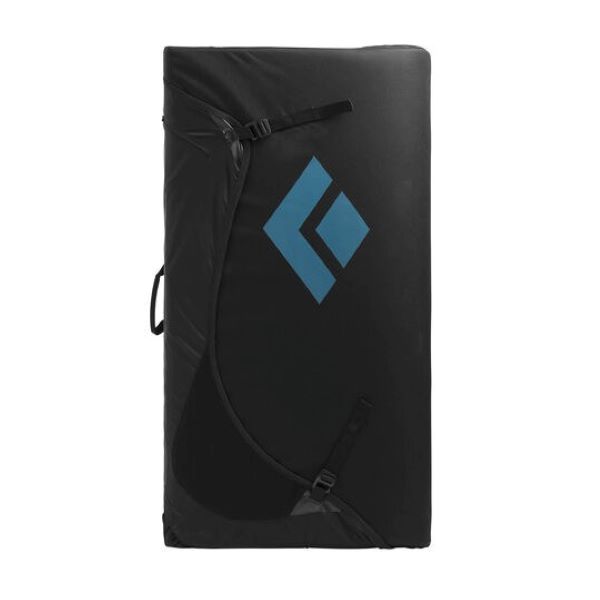
Style: Taco
Size: 48 in x 41 in x 3.5 in
Weight: 9 lb 8 oz
Material: Closed-cell PE foam on top, high-compression PU foam on the bottom, PU-coated 1000d nylon shell
Described by its maker as “The perfect daily driver for the dedicated boulderer,” the Black Diamond Drop Zone is perfect for any boulderer, beginner to elite, looking for an affordable pad to suit general climbing needs. While this pad may not be best for huge traverses or heart-pounding highballs, its continuous style and flexible nature easily adapts to all manner of terrain. If using it on flat ground, it’ll work nicely with other pads since Black Diamond just redesigned the formerly rounded corners into square ones.
An elastic mesh flap keeps the taco firmly shut with shoes and chalk inside while allowing for fast access. Plus, it’s extremely easy to haul, even on long approaches thanks to the waist belt and newly updated suspension system (not that you need it, seeing as this pad weighs a measly 10 pounds)
The new Drop Zone also features a more durable shell that’s both abrasion and water-resistant so you can boulder year-round without concern of what the elements are doing to the foam inside.
Best value crash pad: Metolius Session II Crash Pad
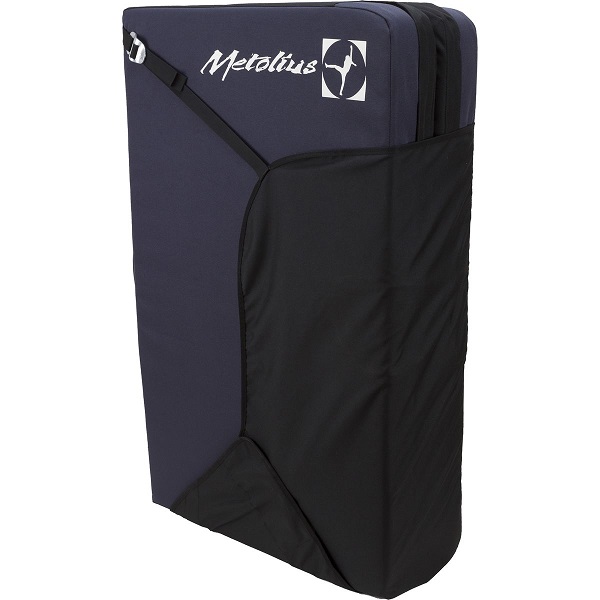
Style: Hinge bi-fold
Size: 48 in x 36 in x 4 in
Weight: 9 lbs
Material: Closed-cell ground layer, open-cell foam core layer, closed-cell top layer, 900D nylon shell
A compact package at a compact price, the Metolius Session II is built for running from boulder to boulder.
Whether you’re just getting started in the sport or looking to pad out your crash pad collection for more serious bouldering this is a great budget pad.
Between its small size and hinge fold, this pad is incredibly compact and easy to haul, especially in conjunction with other pads. Don’t let its small size fool you though; by combining closed-cell foam with high-compression open-cell foam that’s less soft than most, it provides ample fall protection.
Other features include the speed hook aluminum buckles on the closure flap, padded shoulder straps, a waist belt, and suitcase handles for easy spotter movement. For a no-frills budget crash pad, Metolius has all their bouldering bases covered with the Session II.
Best bouldering pad for big or flat landings: Metolius Recon
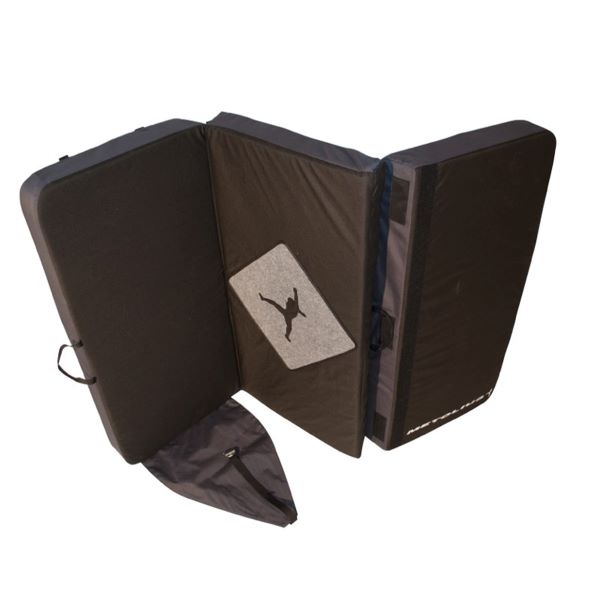
Style: Hinge tri-fold
Size: 60 in x 42 in x 4 in
Weight: 14 lbs. 5.1 oz.
Material: 1 in. of closed-cell foam on top, 2.5 in. of open-cell foam in center, 0.5 in. of closed-cell foam on the bottom, 900-denier fabric shell with ballistic nylon on the bottom
If lengthy traverses and lowball buttdraggers are your thing, the Metolius Recon should be your bouldering pad. Thinner than most pads, it’s not very useful for high falls, but it provides an amazing extra 5.5 sq. ft. of coverage than the standard size pad.
Even so, it folds up into a skinny and compact package thanks to the tri-fold design. For those worried about the weak gutters of hinge pads, the Recon features angled hinges between all panels to protect you from these vulnerable points and velcro in the hinges to prevent the pad from folding. Despite excelling on flat terrain, it also provides a fair bit of versatility in uneven terrain thanks to the ability to fold up two panels while leaving the other unfurled to cover protruding rocks.
The Recon also includes a carpeted logo to wipe your shoes clean, a pocket integrated to the inner top flap (which isn’t big enough to carry much more than a chalk bag), padded shoulder straps, a waist belt, and closure flaps to hold a minimal amount of gear (like shoes).
One big downside to this pad is how uncomfortable it can be to carry over long approaches. Its weight isn’t overly much, but its length makes it hang below the waist which can provide some back discomfort and challenges while scrambling on tougher terrain. It’s also difficult to pair with other pads, though the straps on the flap closures are just barely long enough so that you can strap two Recons together (though be warned: the load isn’t pleasant!).
If this pad STILL isn’t quite big enough for you (and you don’t mind carrying an extra 5 pounds), you can upgrade to this pad’s larger twin: the Metolius Magnum.
Best bouldering pad for highballs: Mad Rock Mad Pad
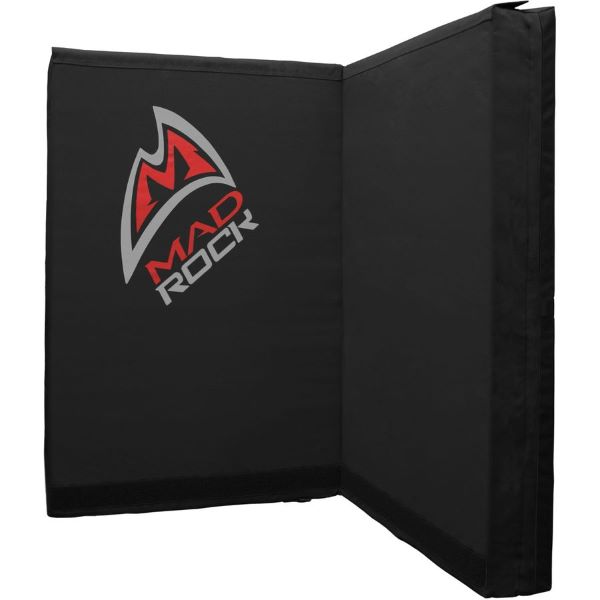
Style: Hinge bi-fold
Size: 48 in x 36 in x 5 in
Weight: 14 lbs
Material: 1 in closed-cell foam on top, 3 in open-cell foam core, 1 in closed-cell foam on the bottom, non-waterproof nylon shell
Another great pad in terms of affordability and versatility is the Mad Rock Mad Pad. Lightweight and extremely cushy with 5 inches of foam, the Mad Pad is perfect for just about any type of climbing. However, it especially excels for highball climbing, with 3 inches of cloud-soft open-cell foam sandwiched in between two outer layers of closed-cell foam to distribute fall force. If you’re looking for a pad that actually feels good to hit while still providing stiff support, this is it.
For extreme highballs, expand your landing surface areas with a couple of these babies side by side. The Mad Pads eliminate the issue of falling into a seam with velcro strips on all sides allowing two Mad Pads to totally seal together into one giant pad. Speaking of velcro, you don’t even have to worry about hitting the hinge and having the pad collapse on you thanks to the back velcro strap that keeps the pad open under force.
Finish off with a removable shoe-wiping carpet, padded shoulder straps, a briefcase handle, and the ability to convert into a chair and you have one super-versatile piece of gear.
Unfortunately, this pad has the weakest exterior shell of all pads on this list. Not waterproof and not very abrasion resistant either, be prepared to patch the holes on a regular basis.
Best bouldering pad for big, serious boulders: Black Diamond Mondo
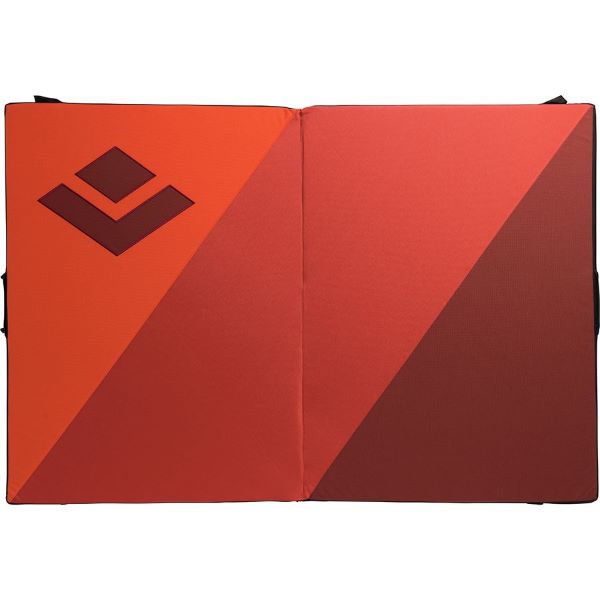
Style: Hinge bi-fold
Size: 65 in x 44 in x 5 in
Weight: 20 lbs, 6 oz
Material: Closed-cell PE foam on top, high-compression PU foam on bottom, rubber-coated bottom shell
To say the Black Diamond Mondo is a big crash pad is an understatement. It’s, well, MONDO! Providing 12 square feet of landing area, you won’t find another single pad that covers quite as much ground as this one.
Plus, with 5 in. of total foam and primarily closed-cell construction, it provides a lot of cushion and force distribution for big falls off big boulders. You’re not going to get the soft cushion of Mad Pad, but you will get more complete fall protection.
The rubber-coated bottom not only bestows this pad with great weather and abrasion-resistance, but it actually helps the pad stay in place. Then, when your spotters need to move it quickly, it features a grab handle in each corner for fast and easy readjustments.
Of course, if you’re solo bouldering, this pad is also one of the best investments you can make, as it’ll cover as much if not more ground than even two other pads put together…. without the headache of strapping two pads together for the approach. Though don’t underestimate the weight of hauling this 20-pound pad, even on its own.
Best bouldering pad for portability: Petzl Cirro
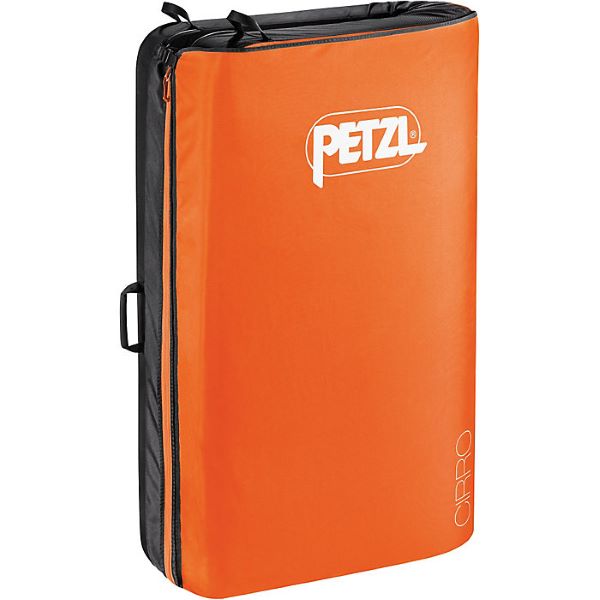
Style: Taco with zippered closure
Size: 46 in x 39 in x 4 in
Weight: 12.5 lbs
Material: 3 in open-cell foam, two 0.5 in closed-cell foam layers
The Petzl Cirro pad is by far the most portable pad on the market, between its convenient zippered sheath to keep all your gear in place and lightweight design. No wonder this pad is named after a cloud: it only weighs 12.5 pounds!
It boasts all the rugged ground covering benefits of a taco pad while remedying one of the biggest complaints of the design: gear falling out on the approach. The Cirro keeps gear in place with an integrated zippered flap that totally encases the pad and all your gear for the approach. Some reviews note this feature does make it tricky to haul particularly bulky items, but otherwise, it’s really helpful on longer approaches where you might be hauling lots of goodies for a long day out. If you’re just moving from one boulder to the next, don’t worry about zipping everything up; a shoulder sling strap takes care of short-distance transportation.
This zippered cover works while hiking and climbing. Once at the crag, flip it inside out and zip it around the shoulder straps to ensure they don’t get snagged on a rock or root, making it easy for on-the-fly adjustments by spotters.
Another reason this pad is superior for portability is the fact that it easily fits its little sibling pad, the Nimbo spotter/sit start pad. Just tuck the pad inside the zippered compartment and you have a fully versatile pad set up all in one neat little bundle.
The biggest downside to this pad is the price. As with all Petzl goods, they don’t run cheap, but they are built to last. Petzl doesn’t make anything second-rate so you can buy knowing this pad will keep cushioning your falls for years to come with proper care.
This pad is also not designed for highball bouldering. With only 1 in. total of closed-cell foam and 3 in. of open-cell foam, it provides a soft landing, but not a very supportive one for higher falls.
Best bouldering pad for uneven landings: Mad Rock R3
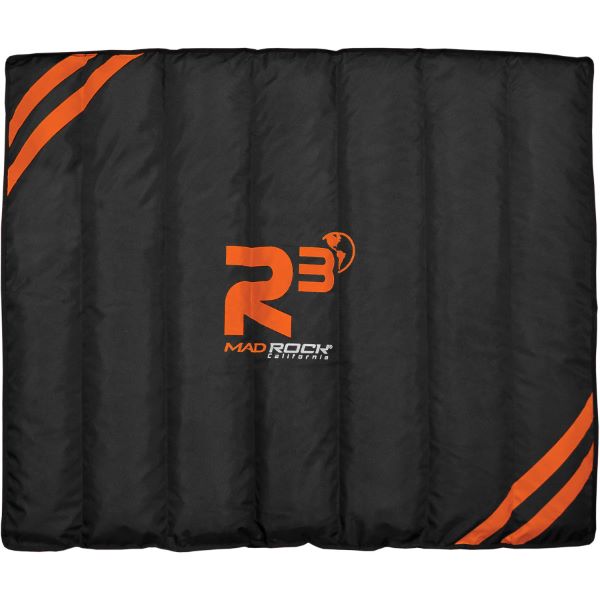
Style: Baffled taco
Size: 55 in x 35 in x 4 in
Weight: 18 lbs
Material: Shredded EVA recycled foam, water-resistant 1680 denier nylon shell
Bouldering crash pad reviews rave about this unusual looking pad, and no wonder considering Mad Rock pretty much invented their own crash pad design on this one.
The R3 is currently the only pad on the market featuring a baffled taco design. That essentially means the pad consists of recycled foam rubes (rather than flat layers) connected by padded hinges. This style means the pad performs remarkably well to a wide variety of terrain. Compared to hinge and taco pads, which can really only lay more or less flat (with varying degrees of success accommodating for angles), the R3 actually conforms to the terrain and better fills in awkward holes.
However, the baffle style also has one big downside to keep in mind: more failure points. Remember with hinge pads, the point at which the two pieces of foam meet are a point that you are not fully protected. With baffle pads, there are multiple hinges and thus multiple failure points. Fortunately, each hinge of the R3 is also reinforced with a little foam so you will never completely blow through to the ground; it just might not feel the best.
Not only is the R3 the most unusual pad out there, but the most eco friendly. R3 refers to the good old 3Rs of sustainability: Reduce, Reuse, Recycle. It’s the first (and so far only) crash pad filled with recycled EVA foam. What’s more, Mad Rock sells foam refills if you need to replace some blown-out baffles without needing to replace the whole pad itself.
Another major perk to this pad is the spacious compartment its unique design yields when folded up. Somewhere between a taco and a sushi roll, you’ll find it easy to stuff all your gear into the center of the pad, while the outer sheath keeps it from falling out.
Explore More
Related articles you'll loveFree Rock Climbing eBooks on Technique, Knots, Training, and More
Video: Bouldering as a Training Tool — Tips from Adam Ondra
Gear Guide: Best Climbing Equipment for Beginners
12 Tips to a Successful Bouldering Strategy
6 Best Training Recovery Tools for Climbers
Our 30+ most popular articles ever
Community Discussion: Most Popular Climbing Shoes
23 Best Gifts for Rock Climbers
Get daily content updates by Liking us on Facebook

